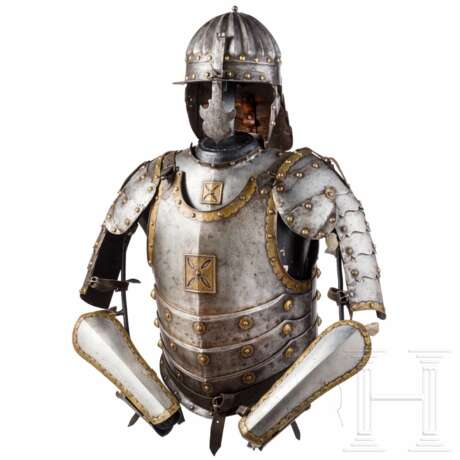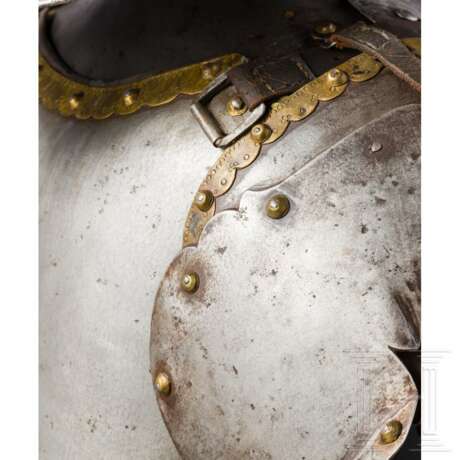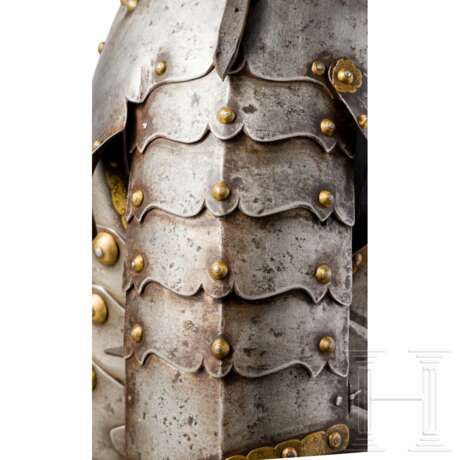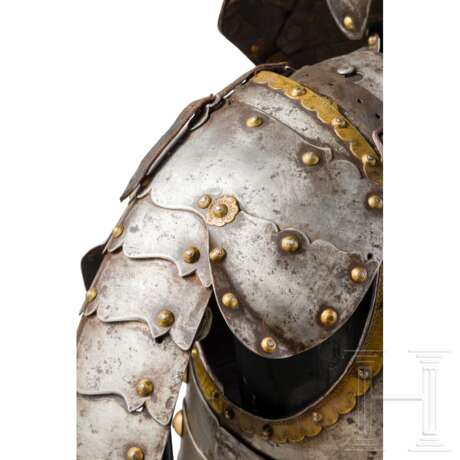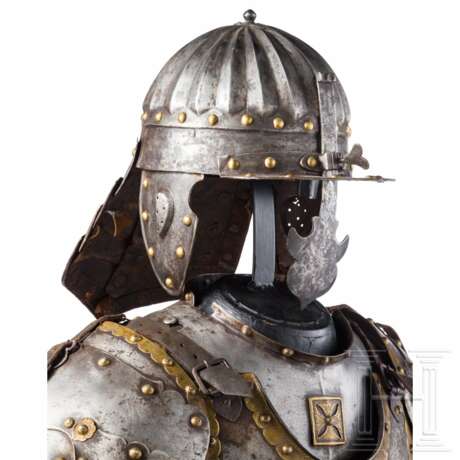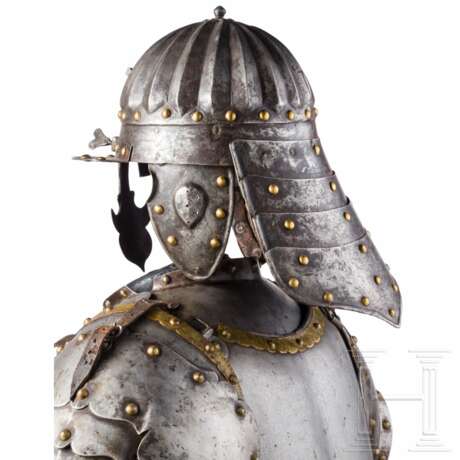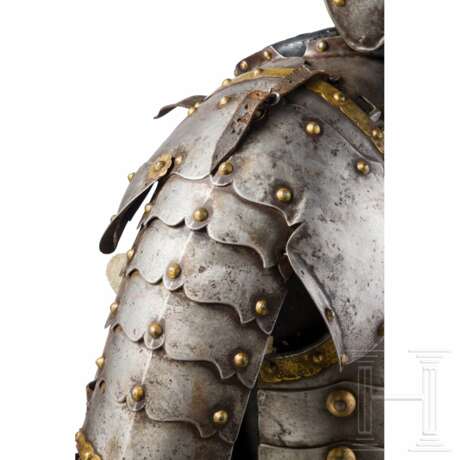ID 1417920
Lot 5360 | Harnisch eines Flügelhusaren, Polen-Litauen, 2. Hälfte 17. Jhdt.
Zischägge mit zweiteilig gearbeiteter Kalotte, umlaufend 19-fach kräftig gegratet. Im Scheitel vernietete blütenförmige Platte mit kleinem Knauf. Am unteren Rand umlaufend messingplattierte Futternieten. Vernieteter, spitz zulaufender Augenschirm mit gebördeltem Rand, verstellbares Nasal. Anhängende Wangenklappen mit gebördeltem Rand, tropfenförmiger Buckel mit gelochten Gehöröffnungen. Vernieteter, dreifach geschobener Nackenschirm mit Zierbesatz aus messingplattierten Nieten. Im Scharnier zu öffnender Kragen mit Messingrand und formal aufgelegtem Messingkreuz. Schwere, dreifach geschobene Kürassbrust mit kräftigem Mittelgrat und reichem Messig-Zierbesatz. Passende, dreifach geschobene Rückenplatte mit Messing-Zierbesatz. Große, sechsfach geschobene Schultern. Im Scharnier zu öffnende, kräftig gegratete Unterarmschienen mit Messing-Zierbesatz. Belederung teils erneuert. Auf modernem, eisernem Ständer montiert. Höhe ca. 85 cm, mit Ständer 165 cm.
Die Flügelhusaren, auch Husaria genannt, waren eine aus den Husaren entwickelte polnisch-litauische Kavallerieinheit, die im 16. und 17. Jhdt. den Kern der polnisch-litauischen Armee bildete. Ihren bedeutendsten Sieg errang sie 1683 in der Schlacht am Kahlenberg, wo es ihr unter der Führung von König Johann III. Sobieski gelang, das Wien belagernde osmanische Heer vernichtend zu schlagen.
A Polish-Lithuanian hussar's suit of armour, 2nd half of the 17th century
A Polish-Lithuanian hussar's suit of armour, 2nd half of the 17th century
Zischägge with two-piece skull decorated with 19 continuous distinct ridges. In the centre a riveted blossom-shaped plaque with small knob. The lower edge with continuous brass-plated lining rivets. Riveted, pointed peak with turned edge, adjustable nasal bar. Attached cheek pieces with turned edge, drop-shaped boss with perforated openings for hearing. Riveted neck guard of three lames with decorative fittings of brass-plated rivets. Hinged gorget with brass edge and formally applied brass cross. Heavy cuirass breast plate of three lames with distinct central ridge and rich decorative fittings of brass. Matching backplate of three lames decorated with brass fittings. Large shoulders sliding on six lames. Hinged vambraces with distinct ridges and decorative brass fittings. Leather cover partly replaced. Mounted on a modern iron stand. Height approx. 85 cm, with stand 165 cm.
The winged hussars, also called husaria, were a Polish-Lithuanian cavalry unit that emerged from the hussars and formed the core of the Polish-Lithuanian army in the 16th and 17th centuries. They achieved their major victory in the battle at Kahlenberg mountain in 1683, where they fought under the command of King Johann III Sobieski and succeeded in defeating the Ottoman army, which had besieged the city of Vienna.
Condition: II
| Catégorie maison de vente aux enchères: | Armes de protection |
|---|
| Catégorie maison de vente aux enchères: | Armes de protection |
|---|
| Adresse de l'enchère |
Hermann Historica Bretonischer Ring 3 85630 Grasbrunn / München Allemagne | ||||||||||||||
|---|---|---|---|---|---|---|---|---|---|---|---|---|---|---|---|
| Aperçu | |||||||||||||||
| Téléphone | +49 (0)89 5472 649 0 | ||||||||||||||
| Fax | +49 (0)89 5472 64999 | ||||||||||||||
| Commission | 25 % | ||||||||||||||
| Conditions d'utilisation | Conditions d'utilisation | ||||||||||||||
| Heures d'ouverture | Heures d'ouverture
|
